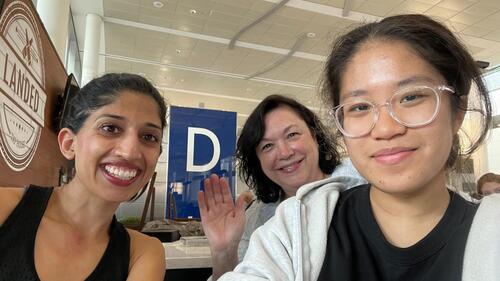
'Truly an awesome feeling'
Experiment built by engineering student Olivia Ye set to blast into space on a Blue Origin rocket

Experiment built by engineering student Olivia Ye set to blast into space on a Blue Origin rocket
By Brian Caldwell Faculty of EngineeringAn experiment inspired by Silly String and built by a first-year engineering student at the University of Waterloo is scheduled to travel into space today aboard a Blue Origin rocket.
Olivia Ye, who is studying mechatronics engineering, was still in high school in her hometown of Newmarket when she participated in an online Shad Canada program two years ago that will culminate with a launch in Texas.
“Knowing that something you made is being sent to space is truly an awesome feeling,” she said.

The experiment built by engineering student Olivia Ye had to fit into a four-by-four-by-eight-inch box.
Ye was on a 10-member team of high school students that won a challenge during a Shad program in the summer of 2020 to develop a research experiment to be conducted in microgravity aboard New Shepard, one of Blue Origin’s reusable rockets.
Competing against 600 other students from across Canada, Ye and her teammates started out brainstorming around the use of Silly String, but couldn’t come up with an experiment to meet a requirement that it have both scientific and social impact.
Their research on the chemistry of Silly String, however, led to the discovery of a 2009 experiment by the European Space Agency on the stability of foam in space and a winning idea was born.
Ye, her teammates and mentors including Dr. Shawna Pandya, a Canadian physician and scientist-astronaut candidate, and Aaron Persad, a research scientist at the Massachusetts Institute of Technology, have since refined a project meant to make better polyurethane foam in the microgravity of space.
“When solid foam is created on Earth, the fluids are dragged down by gravity, which affects bubble formation and its material properties,” Ye said.
“Our goal is to create foam in reduced microgravity and compare its material properties, such as its tensile strength and heat resistance, against a control foam created on Earth.”
Packed into a four-by-four-by-eight-inch box, the experiment – to be automatically triggered by flight data sent via a wired connection – is one of 36 payloads from academia, research institutions and students around the world scheduled to travel into space Aug. 31 on an unmanned flight.
Ye, who got some help along the way from mechatronics engineering classmate Andy Meng, also a participant in the Shad program in 2020, eventually hopes to combine interests in space exploration and robotics in her career.

(L-r) Dr. Shawna Pandya, Deborah Currie of Shad Canada and Olivia Ye.
In the meantime, her role as lead student engineer for the project has taught her valuable lessons on the social, medical and engineering aspects of space, as well as how to create mechanical, electrical and software systems capable of surviving the fluctuating g-forces and vibrations of space flight.
“It was a challenge to ensure that the payload would be able to withstand these conditions to carry out the original foam experiment while staying within a very tight volume and mass budget,” Ye said. “We were able to work through these issues and create a payload that we are proud of.”
The successful effort has also been exciting for Deborah Currie, the point person for Shad, who picked the finished product up from Ye and carefully packed it in materials including – fittingly – polyurethane foam to ensure it shipped safely to Texas for the launch.
"Working closely with Olivia and her teammates over the last two years and watching their winning idea come to life as an actual payload experiment that will fly to space has been a highlight of my career," she said.
The other members of the team, dubbed Mous4Inc., are: Alex Balbino, Sophia Caranci, Zamaan Hussein, Mia Medic, Deo Narayan, Zadian St-Gelais, Shreya Voore, Annika Waschke and Tina Zou.
Shad, a key partner on the project, provides a live-in STEAM (science, technology, engineering, arts and mathematics) enrichment program for students in grades 10 and 11.
Blue Origin is a private company created by Amazon founder Jeff Bezos in 2000 with a vision of millions of people living and working in space for the benefit of Earth.
Banner image credit: Blue Origin media gallery.

Read more
Here are the people and events behind some of this year’s most compelling Waterloo stories

Engineering master's student Nayeema Nonta (left), one of the three paper authors, and her supervisor, Dr. Sirisha Rambhatla, in a large server room with the computer power needed to develop their new LLM training technique. (University of Waterloo)
Read more
Waterloo researchers develop highly efficient AI training system that paves the way for cheaper, greener “intelligent partners”

Read more
Engineering researchers team up to tackle the plastics pollution problem with microbial innovation and engineering design
The University of Waterloo acknowledges that much of our work takes place on the traditional territory of the Neutral, Anishinaabeg, and Haudenosaunee peoples. Our main campus is situated on the Haldimand Tract, the land granted to the Six Nations that includes six miles on each side of the Grand River. Our active work toward reconciliation takes place across our campuses through research, learning, teaching, and community building, and is co-ordinated within the Office of Indigenous Relations.